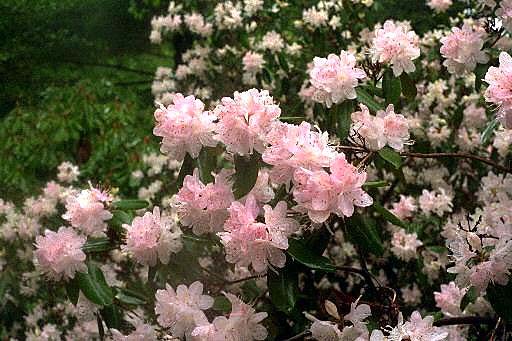(R. minus - Michaux in Fl. Bor. Amer., Vol. 1 (1803))
(R. carolinianum- Rehnder in Rhodora, Vol. 14 (1912) 99)
by Susannah G. Cooper

R. minus var. minus photographed by Robert. J. Mckenzie
Kingdom: Plantae
Class: Dicotyledones
Order: Ericales
Family: Ericaceae
Subfamily: Rhododendroidae
Tribe: Rhododendreae
Genus: Rhododendron
Seed: R.minus' seed is round and not winged. It is 0.75-1mm long. The seed coat is a glossy yellow-brown and ribbed[1].
Seedling: R. minus' hypocotyl is light green and finely grooved. The cotyledons are about 2mm long. There are tow types of epicotyl: a few short multicellular hairs or "several very short-stalked or sessile, peltate hairs" [1].
Mature Plant: R. minus, also know as R. carolinianum, is a shrub which is mostly found along stream banks, wooded slopes in the lower mountains and plains. It typically grows 92m-2.44m high.. The plant is a compact shrub. The leaves are about 4.6-10.8cm long and 1.8-4.6cm wide and are elliptic, oblong-lanceolate, or lanceolate in shape. The topside of the leaf is a dark or pale green and slightly convex. The underside is a brown and scaly [2]. The flower bud is terminal; it is green-brown and 7-10mm long [3]. The flowers bloom from May to June with inflorescences which contain 4-12 flowers. The flowers are funnel-shaped; its size ranges from about 2-3cm. The flower coloration is pink to white. The flower has 10 stamens, about 1.3-3cm in length [2]. The capsule is oblong, about 8-10mm in length [3].
Area |
Status |
Source |
| North America: Canada; continental U.S. | Yes | Swanson 1994 |
| eastern North America: U.S. east of the Mississippi; Ontario, eastern Canada | Yes | Swanson 1994 |
| southern U.S: AL, AR, DE, DC, FL, GA, KY, MD, NC, SC, TN, VA, WV | Yes, usually found in mountainous regions | Swanson 1994 |
| southern Appalachian states: AL, GA, KY, MD, NC, SC, TN, VA, WV | Yes | Swanson 1994 |
| Coastal Plain | No | Mellinger 1984 |
| Piedmont | Yes | Mellinger 1984 |
| Blue Ridge | Yes | Mellinger 1984 |
| Blue Ridge- Great Smoky Nat'l Park | Yes | Mellinger 1984 |
| Ridge and Valley | Yes | Mellinger 1984 |
| Cumberland Plateau | Marginally | Mellinger 1984 |
| Central Arch | ? | - |
| Georgia | Yes | Mellinger 1984 |
| Georgia, Clarke County | Yes | Mellinger 1984 |
| Georgia, Clarke County, Sam's Farm | No, information; possibly- it grows on lower mountains and plains |
R. minus is native to North and South Carolina, Tennessee, and Georgia. Andre Michaux was collecting plants for the French government in the Appalachian mountians and discover this species. He first decribed as a variety R. minus by Michaux in Flora Boreali America in 1803. In 1912, Rehder called the species R. carolinianum in Rhodora. The name was later change later to R. minus var. R. minus. Both names are still closely associated with the species. In my research, many sources refered to the species by both names [7].
Please refer to cultivation section on genus page.
[1] Hedgaard, J. Morphological Studies in Genus Rhododendron: Dealing with Fruits, Seeds, Seedling and their Associated Hairs. G. E. C. Gads Publishing House: Copenhagen.
[2] Davidian, H. H. 1982. Rhododendron Species Vol I: Lepidotes. Timber Press: Portland. p.91-95.
[3] Swanson, R .E. 1994. A Field Guide of the Trees and Shrubs of the Southern Appalachians. John Hopkins University Press: Baltimore. p. 305-308
[4] Duncan, W. H. and Duncan, M. B. 1988. Trees of the Southeastern United States. University of Georgia Press: Athens, GA. p.220
[5] Mellinger, M. B. 1984. Atlas of Vascular Flora of Georgia. Studio Designs Printing: Milledgeville, GA.
[6] Street, J. 1987. Rhododendrons. Globe Pequot Press: Chester, Connecticut. p15-18.
[7] Kneller, M. 1995. The Book of Rhododendrons. Timber Press, Portland. p66
![]()